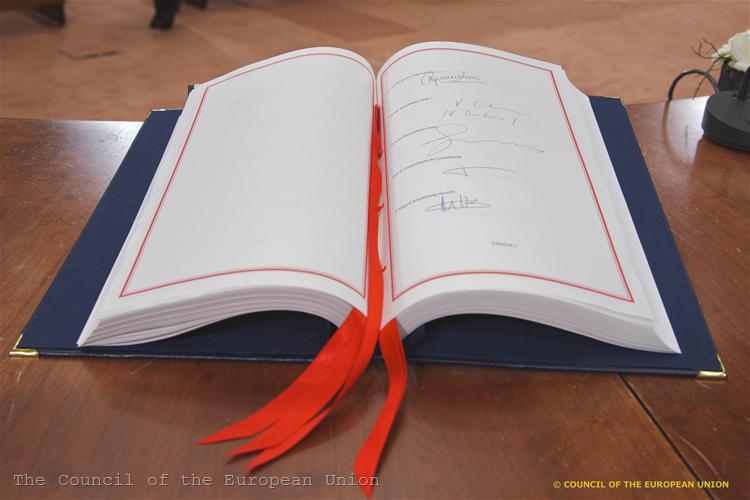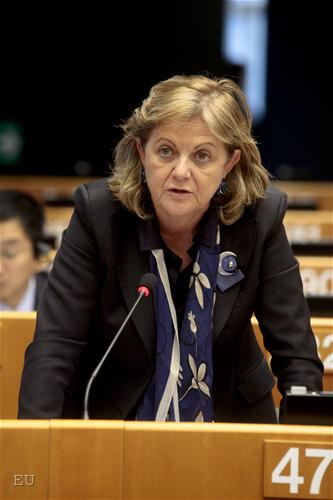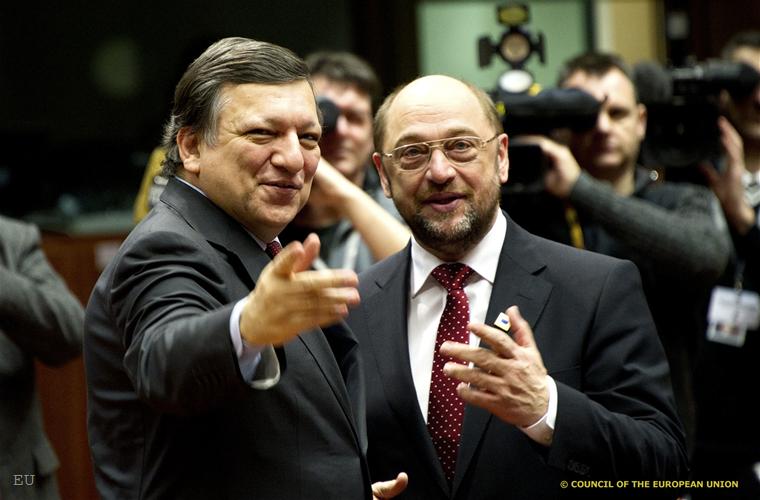Accession to the Fiscal Compact is Limited in Version 3
Adelina Marini, Ralitsa Kovacheva, January 13, 2012
 The fiscal pact will no longer be open for every EU member state that decides to join in at a later stage, but there will be an application procedure. This becomes clear in the new Article 15 added in the third version of the treaty, spread in the beginning of the week in the public domain by the Open Europe think-tank. The new text makes it clear that the Treaty can be joined by other EU member states but only after they apply for membership and after being approved by the contracting parties. This is a very significant change against the backdrop of the previous texts, because from the outset the initiators' wish, France and Germany, was for as broad as possible support.
The fiscal pact will no longer be open for every EU member state that decides to join in at a later stage, but there will be an application procedure. This becomes clear in the new Article 15 added in the third version of the treaty, spread in the beginning of the week in the public domain by the Open Europe think-tank. The new text makes it clear that the Treaty can be joined by other EU member states but only after they apply for membership and after being approved by the contracting parties. This is a very significant change against the backdrop of the previous texts, because from the outset the initiators' wish, France and Germany, was for as broad as possible support.
The idea was supported by all member states except Britain. However, within the working group many countries started putting up conditions that they would join but only part of the provisions, at a later stage or never. Bulgaria is also among the countries that is awaiting the final text in order to decide what part of it is good for the country. The biggest fear, not only of Bulgaria, is if tax harmonisation would be enshrined in the text, which is not the case so far.
The text of this new article, as well as the new title of version 3 inclines to thinking that the direction of the pact already is getting clearer. If in Version 2 the title was "International Treaty on a Reinforced Economic Union", in Version 3 the title now is "Treaty on Stability, Coordination and Governance in the Economic and Monetary Union", which is the full name of the eurozone. This is precisely why yet in the preamble of the treaty it is pointed out that the European Commission proposals of January 23rd are welcome. One of the proposals is for strengthening economic and budgetary surveillance of countries, threatened by serious financial instability in the euro area (the countries with bailouts) and the other is for increasing budgetary surveillance in the euro area.
What impresses is that in the third version of the pact several times the Stability and Growth Pact (SGP) is mentioned, which means that the contracting parties take its rules for leading principles as well as the entire EU legislation, which has a priority.
Many new texts are added, some are just made more precise, while others are with insignificant changes in expression, which is why below we will present to you only those changes we consider of great significance. Such, for example, is the new text added yet in the preamble, with which a commitment is made to "respect the role of social partners, as it is foreseen in the law of each of the Contracting Parties".
Another very important text is expanded, related to the countries with financial difficulties. In the third edition of the document an old German demand is explicitly stipulated for the assistance provided under the European Stability Mechanism (ESM) - adhering to the "golden rules" for debt and deficit would be a condition for receiving rescue from the ESM.
Article 3 represents the fiscal pact in essence, in which the fiscal parameters are outlined, which the participating countries agree to apply and in which there are also some worth the attention changes. But before that it is important to mention that if in Version 2 the contracting parties increased notably the European Commission's role in its implementation, now in Version 3 there is a withdrawal. In the previous version it was provided, except a participant country to bring to the European Court of Justice a partner country for not sticking to its commitments, the European Commission too to do that on behalf of the other participant countries. In the latest version it is pointed out that a member country can bring such a matter to the European Court of Justice or to invite the Commission to come up with a report on the issue. In that case, if the Commission confirms that there is a breach of rules in its report, then the matter can be raised with the European Court of Justice but by the contracting parties.
An important change is introduced in Article 3, which concerns the fiscal pact. Now a concrete deadline is proposed within which the fiscal pact should be incorporated into national legislation, preferably in the constitutions of the member countries. Within one year after the entry into force of the Treaty the participating countries have to enshrine its provisions in their constitutions. In the previous text, in the subsection where a reference was made for the budget deficit it was stipulated that the conditions to achieve the common goal of the governments of the participating countries to have a balanced budget or a surplus will be deemed respected if the annual structural deficit of the governments does not exceed country specific values in line with medium term perspectives, ensuring that the ceiling of 3% will be respected. It is explicitly specified, though, that the national reference value of the structural deficit should not exceed 0.5% of GDP.
With the new changes, however, it is pointed out that the national medium term objectives have to be in line with the Stability and Growth Pact and the deficit should not exceed 0.5% of the gross domestic product at market prices. Besides, it is added that the countries have to ensure convergence with their medium term objectives which will be evaluated on the basis of an overall assessment with the structural balance as a reference, including an analysis of expenditure net of discretionary revenue measures.
In the previous version conditions were laid out for deviation of the objectives for the budget deficit but in the new version it is talked about a temporary deviation in a much broader context, without explicitly mentioning budget deficit. The text about the debt is also more precise. Before an opportunity was given to countries, whose debt levels were remarkably below the boundary of 60% of GDP to have a higher structural deficit ceiling - instead of 0.5%, as with the others, only 1.0%. In the new draft, though, it is said that this can happen only if there are low risks for the long term stability of public finances.
One of the main provisions in the treaty, introducing automatic sanctions by a reversed majority, is changed in a direction that allows various interpretations. In the previous version it was said that the contracting parties from the eurozone agree to support the proposals or recommendations of the European Commission in case of a violation of one of the criteria for debt or budget deficit in the framework of the excessive debt procedure. These recommendations were envisaged to be rejected by a qualified majority. In the new version it is written that the obligation to adhere to the European Commission recommendations shall not apply "where it is apparent among the Contracting Parties whose currency is the euro that a qualified majority of them, calculated by analogy with the relevant provisions of the European Union Treaties without taking into account the position of the Contracting Party concerned, is of another view".
The new formulation is much vaguer than the previous one, but especially confusing is the expression "when it is apparent". This puts into question the definition of qualified majority when it will be defined not according to but "by analogy" with the European treaties. This type of majority was introduced with the Lisbon Treaty and means: there is a qualified majority when 55% (when voting on a European Commission proposal, otherwise the percentage is 72) of the member states that represent 65% of EU population support a proposal.
As mentioned in the beginning, the focus of the Treaty is more and more shifting toward the eurozone only. This is even more evident from the title of Chapter V of the third draft of the Treaty. In Version 2 the title of this chapter was only "Governance", while in Version 3 it is already "Governance of the Euro Area".
There is also a change in the conditions for the Treaty to enter into force. In the previous version it was written: after the ratification of 15 participating countries, while now it is proposed the countries to be 12 but the number is put in brackets which can only mean that it is conditional too. Most importantly, however, is that there is already a specific date for its entering into force - 1 January 2013. So far there was no specific date for enforcement.
As with the previous versions now too the representatives of the European Parliament in the working group reacted sharply. According to Elmar Brok (EPP, Germany), Roberto Gualtieri (S&D, Italy), Guy Verhofstadt (ALDE, Belgium) the latest draft is incompatible with the EU treaties and does not defend the "community method" in the decision making process. This is the main criticism of the European Parliament from the onset against the idea for the creation of the Treaty, which is formulated as an intergovernmental agreement. The main fear of the three MEPs is that "the draft does not ensure that every decision to apply the new treaty will be taken within the normal procedures, envisaged in the EU Treaties, in order to ensure democratic control and transparency".
Besides, they say, in order to achieve stability and sustainable growth it is necessary provisions to be included that ensure that fiscal stability "will be accompanied by solidarity and growth".
 | © The Council of the European Union
| © The Council of the European Union | © EU
| © EU | © EU
| © EU